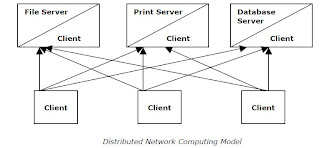Network Computing Models
A network can be designed for processing information by either the client or the server. The network model can also be structured in a way that both the client and the server can process information. Depending on this flexibility, network computing models can be of three types:
Distributed Network Computing Model
The distributed network computing model allows all network computers to take part in processing but at their respective ends, separately. This model allows sharing data and services but does not help the other network computers in processing.
In this network model, a processing-intensive task is broken into a subset of tasks and distributed among multiple nodes. The nodes work on their individual subsets of tasks. The following figure shows the distributed network computing model:
Advantages
Some of the advantages of the distributed network computing model are:
- Faster data access: The distributed network model allows a node to store the information locally. As a result, data can be accessed faster than in the centralized network model.
- High reliability: In the distributed network model, no single point of failure exists because the network does not entirely depend on a single node. This ensures lower network downtime.
- Customized network setup: The distributed network model offers the flexibility of treating different computers as clients and servers. It allows the optimized use of resources because the roles of the server and the client are interchangeable.

No comments:
Post a Comment